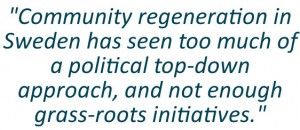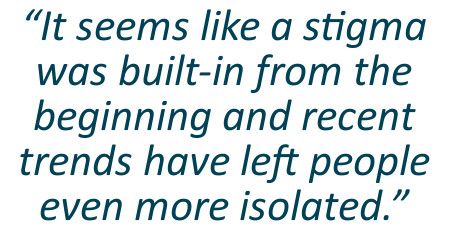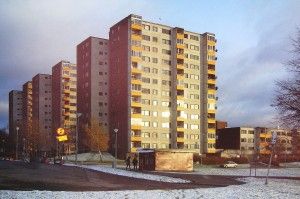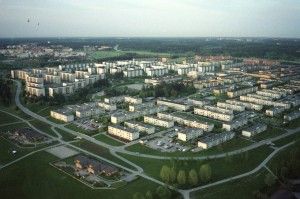SURF has a keen interest in understanding more about responses to place-based regeneration challenges in other countries. In this article, we hear from Swedish regeneration expert Tomas Dahlberg. One million homes were built in new residential estates across the country in the late 1960s and early 1970s, areas that now tend to suffer from social and economic problems. Tomas summarises a 60-year regeneration challenge in 1000 words and explains why Scotland is well-placed to offer inspiration on new community-oriented strategies.
The Million Homes Programme, symbolized by the big residential areas built in the outskirts of the major cities in Sweden between 1965-74, has from the beginning been associated with concrete and sameness.
Starting from a decision in the Swedish Parliament, this ambitious venture to build one million flats initiated a new era in housing development. Industrial and rationalised methods were utilised, and the layout of the new housing was often a result of the tracks used by the building cranes. Sweden at the time was suffering from a major shortage of housing, and also from housing that was considered to be of poor standard, both of which contributed to negative social issues.
A more general housing politic was formed and the state gave big financial support to contractors and housing companies to deliver the programme. Many of the housing companies were also publically owned by municipalities, and the majority of the housing was in the form of rental apartments.
Le Corbusier meets the Folk Home
With the Social Democratic Party in majority in the Parliament for very long period (1932-1976), this was also an attempt to build their vision of the welfare state: “the folk home”. The Swedish policy was at this time, and still is, general, with a central idea of providing every citizen with affordable housing. For those on lower incomes, supplementary benefits were provided. The policies had gradually changed since the 1930s and 40s, when 12,000 flats were built as housing for low-income families with many children (the more children a family had, the lower the rent). But this was considered to be stigmatising.
 But since the public housing companies have in practice always taken social responsibilities for disadvantaged residents and those that cannot solve their housing needs on their own, a Swedish model of social housing developed. The big housing estates that were built were criticised from the beginning, for social aspects and for poor architecture. The planning ideals where inspired by Le Corbusier, ideals which are now associated with animosity and disconnection. Though the houses often lacked good quality architecture, they nonetheless had generally decent standards with central heating and modern kitchens and bathrooms.
But since the public housing companies have in practice always taken social responsibilities for disadvantaged residents and those that cannot solve their housing needs on their own, a Swedish model of social housing developed. The big housing estates that were built were criticised from the beginning, for social aspects and for poor architecture. The planning ideals where inspired by Le Corbusier, ideals which are now associated with animosity and disconnection. Though the houses often lacked good quality architecture, they nonetheless had generally decent standards with central heating and modern kitchens and bathrooms.
Low attractiveness, however, encourages residents to see their housing as temporary. This results in a lower desire to tend to common property and engage in local activities. It seems like a stigma was built-in from the beginning and the rate of unemployment and related social problems has been a key part of the main picture over the years. Trends such as the growth of external shopping centres has led to the closing of local services and shops, which has left people without cars even more isolated.
Top-Down Neglect
The Million Homes Programme areas have also been required to adapt to major periods of immigration. During the ‘60s, many new workers arrived from Finland and Italy, while a high proportion of refugees groups from firstly Bosnia, then Somalia and now the Middle East have settled in these big housing areas outside our bigger cities.
Over the years, several national and regional projects have been launched in the hope of increasing resilience and social capital among the residents. The housing companies have also made great efforts with local projects for employment and vocational training. Their local management has become more resident-orientated and proactive in community relations. The housing companies have made some good progress, but too many of the public interventions with big grants and parachuted-in projects have brought no significant positive outcomes for the intended beneficiaries.
A relevant quote here is: “Nothing about us without us is for us”. Over the years, the housing and regeneration fields in Sweden have had too much of a political top-down approach, and not enough grass-roots initiatives and local community planning.
A consistent problem with most of the larger housing companies and their Million Homes Programme estates is a long term neglect of necessary maintenance. For various reasons, inadequate resources are provided for maintenance. The public debate on this has stressed the fact that many residents in disadvantaged housing areas will find that after renovation investments, their rents have increased so much that they can’t afford it.

Community Participation
Two main national issues on Sweden’s political agenda today are very similar to those that existed before the Million Homes Programme: the great need for regeneration of existing housing stock, and the need to build 461,000 homes by 2020, according to statistics from The National Board for Housing and Planning (Boverket).
The first issue is more than a technical question; it is the awareness that social sustainability and integration has to be addressed properly. Years of perceived neglect has to be dealt with and a better toolbox used. Riots that have occurred have been internationally profiled, and over the last few years increasing radicalisation among Muslim communities has become a national problem. The fact that so many of Sweden’s authorities and civil society organisations are involved in addressing this makes a compelling argument for better inclusion and prevention strategies.
My own research and experience, and research from other bodies, both independent and produced by government agencies, shows that many actors are paying a lot of attention to, and making serious efforts with, citizen and resident participation. Methods for bridging cultural borders and language barriers are being sought out and tested. My opinion is that the cultural planning approach could be the most successful in the long run. The aspiration is to develop cultural planning from ‘planning for culture’ towards ‘survey then plan’ strategies.
I think that prevention strategies with a cultural planning dimension could be adapted for Million Homes Programme areas and integrated within the new housing programme. Too much new-build housing in Sweden is constructed from blueprints that satisfy investor demands first rather than that of the city and its citizens, and this needs to change.
Here is where I think we can most usefully learn from and share experiences with Scotland. The way in which, for example, the Community Empowerment (Scotland) Act will play out is certainly worth following from a Swedish perspective, but what is of even more value is the already established relationships between the community level and the local government and housing association level.
SURF holds a key role around research and evaluation on interactions between community development and government policy, which I believe could serve as a good role model for the development of an independent regeneration body in Sweden.
SURF is working with Tomas with a view to establishing an informal cross-border network of regeneration bodies in north-east Europe. For more on the work of his Creative Communities organisation, visit the website or Facebook page. Tomas is also active on Twitter.


